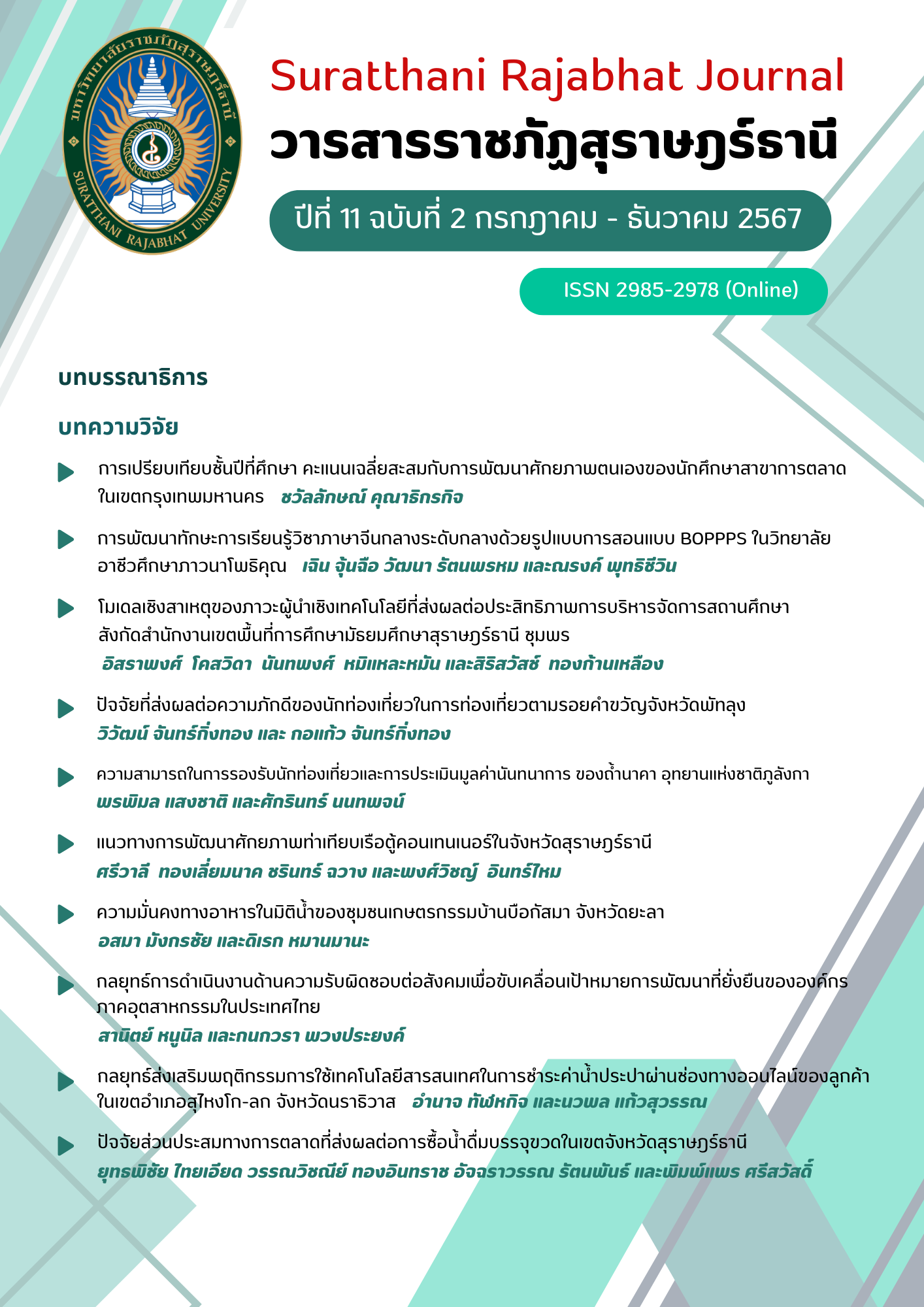โมเดลเชิงสาเหตุของภาวะผู้นำเชิงเทคโนโลยีที่ส่งผลต่อประสิทธิภาพการบริหารจัดการสถานศึกษา สังกัดสำนักงานเขตพื้นที่การศึกษามัธยมศึกษาสุราษฎร์ธานี ชุมพร
Main Article Content
บทคัดย่อ
การวิจัยครั้งนี้เป็นมีวัตถุประสงค์เพื่อ 1) ศึกษาสภาพปัจจุบัน สภาพที่พึงประสงค์ และการศึกษาแนวทางการพัฒนาภาวะผู้นำเชิงเทคโนโลยี 2) พัฒนาโมเดลเชิงสาเหตุของภาวะผู้นำเชิงเทคโนโลยีที่ส่งผลต่อประสิทธิภาพการบริหารจัดการสถานศึกษา 3) ตรวจสอบความเที่ยงตรงเชิงโครงสร้างโมเดลเชิงสาหตุของภาวะผู้นำเชิงเทคโนโลยีที่ส่งผลต่อประสิทธิภาพการบริหารจัดการสถานศึกษา กลุ่มตัวอย่าง ผู้บริหารสถานศึกษา และครูผู้สอน จำนวน 560 คน เครื่องมือที่ใช้ ได้แก่ แบบสอบถาม และแบบสัมภาษณ์รวมทั้งสถิติที่ใช้ในการวิเคราะห์ข้อมูลได้แก่ ความถี่ ร้อยละ ค่าเฉลี่ย ส่วนเบี่ยงเบนมาตรฐาน ค่าสถิติทดสอบที การวิเคราะห์รูปแบบสมการเชิงโครงสร้าง และการวิเคราะห์เชิงเนื้อหา
ผลการวิจัย พบว่า 1) ภาวะผู้นำเชิงเทคโนโลยีของผู้บริหารสถานศึกษา โดยรวมอยู่ในระดับมาก มีนัยสำคัญทางสถิติที่ระดับ .01 รวมทั้งผู้บริหารสถานศึกษาควรมุ่งเน้นการพัฒนาบุคลากร ให้มีทักษะเทคโนโลยีดิจิทัลสู่ความเป็นมืออาชีพ รู้เท่าทันการใช้เทคโนโลยี 2) โมเดลเชิงสาเหตุของภาวะผู้นำเชิงเทคโนโลยีที่ส่งผลต่อประสิทธิภาพการบริหารจัดการสถานศึกษาของผู้บริหารสถานศึกษา ประกอบด้วย 6 องค์ประกอบ 22 ตัวชี้วัด ได้แก่ (1) ด้านการเป็นผู้นำด้านวิสัยทัศน์ (2) ด้านการสร้างวัฒนธรรมการเรียนรู้ในยุคดิจิทัล (3) ด้านการเป็นพลเมืองในยุคดิจิทัล (4) ด้านการปรับปรุงอย่างเป็นระบบ (5) ด้านความเป็นเลิศในการปฏิบัติอย่างมืออาชีพ และ (6) ด้านประสิทธิภาพการบริหารสถานศึกษา มีความถูกต้องเหมาะสม เป็นไปได้ และเป็นประโยชน์ โดยมีค่าเฉลี่ยเท่ากับ 4.85 อยู่ในระดับมากที่สุด และ 3) โมเดลเชิงสาเหตุของภาวะผู้นำเชิงเทคโนโลยีที่ส่งผลต่อประสิทธิภาพการบริหารจัดการสถานศึกษา มีความสอดคล้องกับข้อมูลเชิงประจักษ์ (Chi-Square=143.58, df=138, P-Value=0.35, x2/df=1.04, CFI=0.91, TLI=0.92, RMSEA=0.04) และอธิบายความแปรปรวนของประสิทธิภาพการบริหารสถานศึกษาได้ ร้อยละ 90
Article Details

This work is licensed under a Creative Commons Attribution-NonCommercial-NoDerivatives 4.0 International License.
References
American Institute for Research (AIR). (2009). Evaluation of the school technology leadership initiative: External evaluation report 2. Washington, DC: American Institutes of Research.
Ahmed, S., Ahmed, A. & Ahmad, M. (2017). Application of Multiple Comparison Procedures on an Individual’s Innovative Behavior. Pakistan Journal of Statistics, 3(3), 191–206. https://papers.ssrn.com/sol3/papers.cfm?abstract_id=2982944
Bainbridge, W. (2020). Leadership in Science and Technology : A Reference Handbook. California : SAGE Publications, 14.
Chamchoy, S. (2020). School Management in the Digital Age. (1st edition). Phitsanulok : Naresuan University Press.
Chawanapaisarn, J. (2020). Guidelines on The Development of Technology Leadership of School Administrator in the Tawaravadee Consolidation under The Secondary Education Service Area Office Suphanburi. Department of Educational Administration Graduate School, Silpakorn University.
Ingard, A. (2022). Determining an Appropriate Sample Size and Power of Test with Strength Degree of the Relationship between Variables in the Structural Equation Modeling. MUT Journal of Business Administration, 19(1), 106-121. https://so04.tci-thaijo.org/index.php/journalmbsmut/article/view/259623.
International Society for Technology in Education (ISTE). (2009). National Educational Technology Standard for Administrators. https://shorturl.asia/EX4vm
Keesookpun, A. (2021). School Management in Digital Era. https://www.trueplookpanya.com/knowledge/content/52232/-edu-teaartedu-teaart-teaartdir.
Office of the Basic Education Commission. (2022). Educational development plan of the Basic Education Commission. Bangkok : Ministry of Education.
Pawabutra, C. (2020). Technological Leadership Development Model for the School Administrators in the Digital Age. Journal of Education Administration and Leaderchip, 9(33), 1-11. https://jeal.snru.ac.th/ArticleView?ArticleID=842
Rabadán, P. & Pérez, G. (2020). Improved method for the detection of catheter colonization and catheter-related bacteremia in newborns. Diagn Microbiol Infect Dis, 87, 311-314.
Sutthirak, S. & Leadkaew, S. (2021). Structural Equation Model of Factors Influencing Performance of Community Enterprises. Journal of Social Science and Buddhistic Anthropology, 6(8), 431-447. https://so04.tci-thaijo.org/index.php/JSBA/article/view/250880.
Siobhan, C. & Jason, W. (2019). Top 5 IT Leadership Trends In 2019 : A CIO Report. https://gomindsight.com/insights/blog/top-5-it-leadership-trends-cio-report.
Thannimalai, R. & Raman, A. (2019). The Influence of Principals’ Technology leadership and Professional Development on Teachers’ Technology Integration inSecondary School. Malaysian Journal of Learning and Instruction, 15(1), 203-228. https://www.researchgate.net/publication/326802539_The_Influence_of_Principals'_Technology_Leadership_and_Professional_Development_on_Teachers'_Technology_Integration_in_Secondary_Schools
The Secondary Educational Service Area Office Suratthani Chumphon. (2021). Action Plan 2021. Suratthani : Policy and Planning Group.
Thongkanluang, S. (2020). Model Development on the 21th Century Learning Management Competency that Affects to Learner Quality of Teachers in Surat Thani Province. Journal of Education, Prince of Songkla University, Pattani Campus, 33(1), 94-110. https://so02.tci-thaijo.org/index.php/edupsu/article/view/243477/172073
Tripongpun, K. (2022). Confirmatory Factor analysis of tourism safety for foreign female tourists. Suratthani Rajabhat Journal, 9(1), 40-75. https://so05.tcithaijo.org/index.php/srj/article/view/253876/174660.

